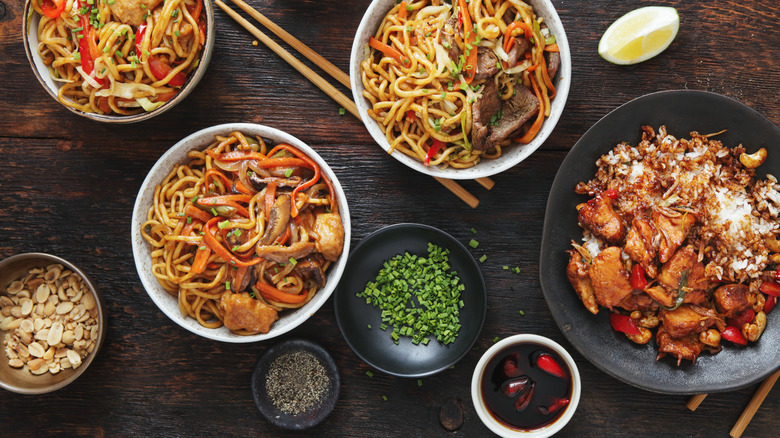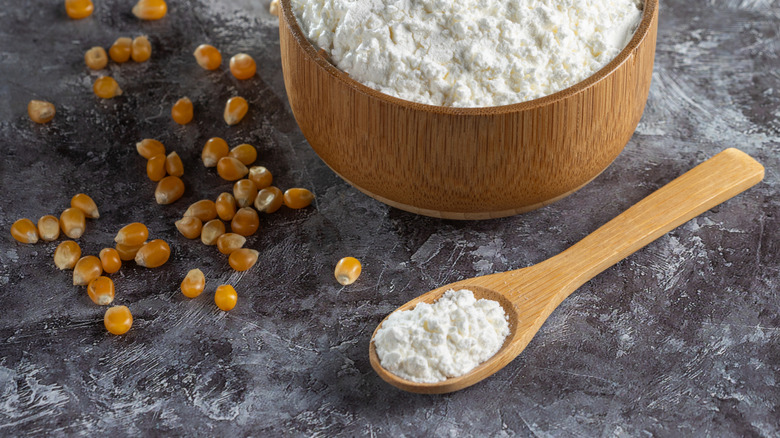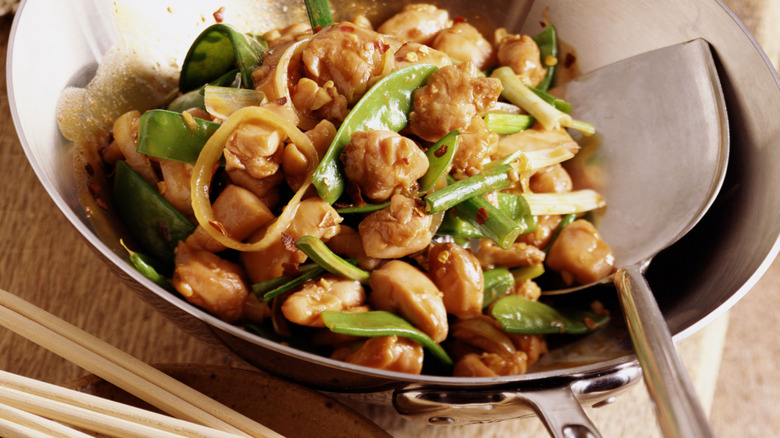Chinese Restaurant Stir Fry Is Better Than Yours Because Of This Technique
There are lots of standbys on many Chinese restaurant menus: Moo Shu beef, Singapore noodles, lo mein, sesame chicken, General Tso's, and sweet and sour pork. But, try as you might, it seems like no matter where you get the recipe, you can never quite replicate those dishes perfectly — especially the ones with chicken as the main ingredient. One of the reasons for that involves the technique used to create that soft, luscious, and succulent bite.
If you're not leaning into the power of velveting your chicken, then you're not going to achieve the perfection that is Chinese stir fry. No, velveting doesn't mean draping your hens in soft fabric and telling them they're fabulous. Rather, velveting is a technique used to soften the fibers of the meat, giving you a delicious and tender bite when the dish is freshly made — or even reheated as leftovers. This isn't an ancient Chinese secret that's inaccessible to those not in the know; It only requires a little science.
How does velveting work?
So, of all the game-changing chicken hacks, does velveting actually work? Although recipes differ in terms of adding vinegar, adding egg white, poaching in water first, poaching in water and oil, or just going straight to frying, all of them rely on the key to success: cornstarch. Cornstarch is just that — the starch derived from kernels of corn. It's used primarily to thicken sauces, soups, and gravies, but in the process of velveting, cornstarch helps to retain the chicken's moisture. When the chicken marinates, the cornstarch prevents the muscle fibers in the meat from contracting when they cook, giving you a juicier and less-tough end result.
As far as the poaching then cooking aspect of velveting, the batter around your chicken pieces essentially creates a barrier to protect the meat from drying out. Poaching chicken in water first will give the outer part of each piece a velvety feel. Then, when those pieces are added to the wok for a fast stir fry, they're already partially cooked, have locked in moisture, and can finish cooking without drying out.
How to velvet your protein at home
You could always reheat Chinese takeout to get that first-bite flavor. Or, you can achieve a restaurant-level stir fry yourself with the help of velveting. First, you'll need to choose a good quality piece of chicken. Be wary of chicken that looks pale and fibrous, as that could be a sign of woody breast. Cuts like thighs tend to be more flavorful and may be better for long braises and stews, but breasts are great in a stir fry since they're lean and cook quickly. Once you've selected your chicken, cut it into bite size pieces. In a large bowl, mix together cornstarch or baking soda and water until it forms a slurry. Some recipes utilize egg white, too, but the overall end result will be similar without it. Add the chicken pieces, and let everything marinate in the refrigerator for about 30 minutes.
After marinating, some recipes call for poaching the chicken quickly in boiling water, drying it, then adding it to hot oil to finish cooking where it develops a beautiful, crunchy, gold exterior. The inside will finish cooking, becoming tender, juicy, and soft. Other recipes advise going straight from the marinade to hot oil in a wok. Whichever way you do it, velveting your chicken will yield tasty results.


